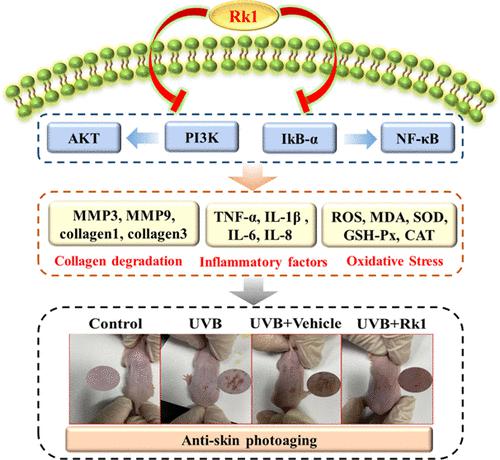当前位置:
X-MOL 学术
›
J. Agric. Food Chem.
›
论文详情
Our official English website, www.x-mol.net, welcomes your
feedback! (Note: you will need to create a separate account there.)
Ginsenoside Rk1 Prevents UVB Irradiation-Mediated Oxidative Stress, Inflammatory Response, and Collagen Degradation via the PI3K/AKT/NF-κB Pathway In Vitro and In Vivo
Journal of Agricultural and Food Chemistry ( IF 5.7 ) Pub Date : 2022-12-06 , DOI: 10.1021/acs.jafc.2c06377 Yannan Liu 1, 2, 3 , Linlin Qu 1, 2, 3 , Shichao Wan 1, 2, 3 , Yingchun Li 4 , Daidi Fan 1, 2, 3
Journal of Agricultural and Food Chemistry ( IF 5.7 ) Pub Date : 2022-12-06 , DOI: 10.1021/acs.jafc.2c06377 Yannan Liu 1, 2, 3 , Linlin Qu 1, 2, 3 , Shichao Wan 1, 2, 3 , Yingchun Li 4 , Daidi Fan 1, 2, 3
Affiliation

|
Long-term exposure to ultraviolet (UV) irradiation, especially UVB, can trigger destructive intracellular effects, including various types of DNA damage, oxidative stress, and inflammatory responses, leading to accelerated skin aging. Ginsenoside Rk1, a rare ginsenoside pertaining to panaxadiol saponins, has been certified to possess underlying anti-inflammatory effects. Nevertheless, the efficiency of Rk1 against the photoaging of human skin and the latent molecular mechanisms are still unclear. Here, UVB-irradiated HaCaT keratinocytes were used as an in vitro model, and UVB-irradiated BALB/c nude mouse dorsal skin was established as an in vivo model to explore the mechanism by which Rk1 protects skin. Consequently, we found that Rk1 administration significantly attenuated oxidative stress by suppressing reactive oxygen species (ROS) overproduction and strengthening the activities of antioxidant enzymes. The UVB-induced inflammatory response was alleviated by Rk1 application via regulation of the secretion of various proinflammatory cytokines. Additionally, western blot assays illustrated that Rk1 intervention inhibited collagen degradation by reducing the expression of matrix metalloproteinases. Further studies revealed that Rk1 could suppress the PI3K/AKT/NF-κB signaling pathways in vitro and in vivo. Molecular docking results indicated that Rk1 might effectively bind to the active pockets of PI3K, AKT, and NF-κB. The PI3K activator 740 Y-P clearly reversed the effects of Rk1 on oxidative stress, the inflammatory response, and collagen degradation in UVB-irradiated HaCaT cells. Moreover, histological and Masson staining verified that the administration of Rk1 to BALB/c nude mice remarkably ameliorated UVB-induced skin roughness, epidermal thickening, collagen fiber arrangement disorder, and wrinkles. Overall, the evidence provided in this study suggested that Rk1 could be applied for the development of effective natural antiphotoaging agents for skin health.
中文翻译:

人参皂苷 Rk1 通过 PI3K/AKT/NF-κB 通路在体外和体内预防 UVB 辐射介导的氧化应激、炎症反应和胶原蛋白降解
长期暴露在紫外线 (UV) 照射下,尤其是 UVB 会引发破坏性的细胞内效应,包括各种类型的 DNA 损伤、氧化应激和炎症反应,从而导致皮肤加速老化。人参皂苷 Rk1 是一种罕见的人参皂苷,属于人参二醇皂苷,已被证明具有潜在的抗炎作用。然而,Rk1 对人体皮肤光老化的功效及其潜在的分子机制仍不清楚。在这里,UVB 照射的 HaCaT 角质形成细胞被用作体外模型,UVB 照射的 BALB/c 裸鼠背部皮肤被建立为体内模型。模型探索 Rk1 保护皮肤的机制。因此,我们发现 Rk1 给药通过抑制活性氧 (ROS) 过量产生和加强抗氧化酶的活性显着减轻氧化应激。通过调节各种促炎细胞因子的分泌,应用 Rk1 可减轻 UVB 诱导的炎症反应。此外,蛋白质印迹分析表明,Rk1 干预通过减少基质金属蛋白酶的表达来抑制胶原蛋白降解。进一步研究表明,Rk1 可在体外和体内抑制 PI3K/AKT/NF-κB 信号通路. 分子对接结果表明 Rk1 可能有效地结合 PI3K、AKT 和 NF-κB 的活性口袋。PI3K 激活剂 740 YP 明显逆转了 Rk1 对 UVB 照射的 HaCaT 细胞中氧化应激、炎症反应和胶原蛋白降解的影响。此外,组织学和马松染色证实,Rk1 对 BALB/c 裸鼠的给药显着改善了 UVB 引起的皮肤粗糙、表皮增厚、胶原纤维排列紊乱和皱纹。总体而言,本研究提供的证据表明,Rk1 可用于开发有效的天然抗光老化剂,促进皮肤健康。
更新日期:2022-12-06
中文翻译:

人参皂苷 Rk1 通过 PI3K/AKT/NF-κB 通路在体外和体内预防 UVB 辐射介导的氧化应激、炎症反应和胶原蛋白降解
长期暴露在紫外线 (UV) 照射下,尤其是 UVB 会引发破坏性的细胞内效应,包括各种类型的 DNA 损伤、氧化应激和炎症反应,从而导致皮肤加速老化。人参皂苷 Rk1 是一种罕见的人参皂苷,属于人参二醇皂苷,已被证明具有潜在的抗炎作用。然而,Rk1 对人体皮肤光老化的功效及其潜在的分子机制仍不清楚。在这里,UVB 照射的 HaCaT 角质形成细胞被用作体外模型,UVB 照射的 BALB/c 裸鼠背部皮肤被建立为体内模型。模型探索 Rk1 保护皮肤的机制。因此,我们发现 Rk1 给药通过抑制活性氧 (ROS) 过量产生和加强抗氧化酶的活性显着减轻氧化应激。通过调节各种促炎细胞因子的分泌,应用 Rk1 可减轻 UVB 诱导的炎症反应。此外,蛋白质印迹分析表明,Rk1 干预通过减少基质金属蛋白酶的表达来抑制胶原蛋白降解。进一步研究表明,Rk1 可在体外和体内抑制 PI3K/AKT/NF-κB 信号通路. 分子对接结果表明 Rk1 可能有效地结合 PI3K、AKT 和 NF-κB 的活性口袋。PI3K 激活剂 740 YP 明显逆转了 Rk1 对 UVB 照射的 HaCaT 细胞中氧化应激、炎症反应和胶原蛋白降解的影响。此外,组织学和马松染色证实,Rk1 对 BALB/c 裸鼠的给药显着改善了 UVB 引起的皮肤粗糙、表皮增厚、胶原纤维排列紊乱和皱纹。总体而言,本研究提供的证据表明,Rk1 可用于开发有效的天然抗光老化剂,促进皮肤健康。






























 京公网安备 11010802027423号
京公网安备 11010802027423号